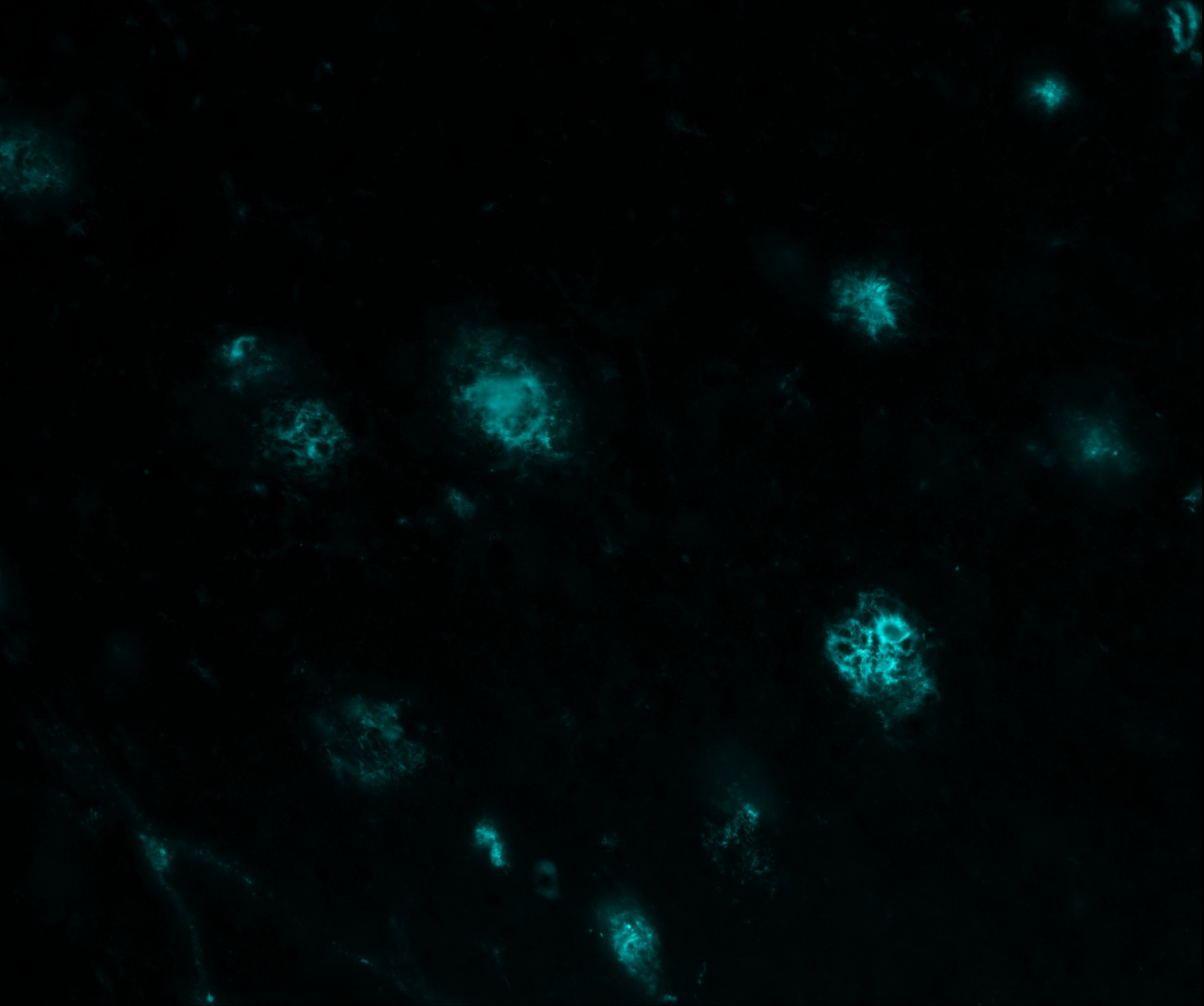| Reactivity | Hu, Mu, Rt, Ba, PmSpecies Glossary |
| Applications | WB, DB, ELISA, ICC/IF, IHC, IP, WB, IHC |
| Clone | MOAB-2 |
| Clonality | Monoclonal |
| Host | Mouse |
| Conjugate | Unconjugated |
| Format | BSA Free |
| Concentration | 1.0 mg/ml |
| Description | Novus Biologicals Mouse beta Amyloid Antibody (MOAB-2) - BSA Free (NBP2-13075) is a monoclonal antibody validated for use in IHC, WB, ELISA, ICC/IF and IP. Anti-beta Amyloid Antibody: Cited in 70 publications. All Novus Biologicals antibodies are covered by our 100% guarantee. |
| Immunogen | This beta Amyloid antibody was developed against recombinant human beta Amyloid 42. |
| Epitope | Residues 1-4 of beta Amyloid |
| Specificity | Beta Amyloid antibody (MOAB-2) recognizes unaggregated, oligomeric and fibrillar forms of beta Amyloid 42 and unaggregated beta Amyloid 40. Does not detect APP. |
| Isotype | IgG2b |
| Clonality | Monoclonal |
| Host | Mouse |
| Gene | APP |
| Purity | Protein G purified |
| Innovator's Reward | Test in a species/application not listed above to receive a full credit towards a future purchase. |
| Dilutions |
|
|
| Application Notes | In Western blot, a band can be seen at ~4 kDa, representing the beta Amyloid monomer. Larger bands may also be seen representing the unaggregated, oligomeric, and fibrillar forms of beta Amyloid. For higher beta Amyloid yield in WB, please follow the extraction protocol described in Youmans et al, J Neurosci Methods. 2011 March 15; 196(1): 51-59 (PMID: 21219931). |
|
| Theoretical MW | 5 kDa. Disclaimer note: The observed molecular weight of the protein may vary from the listed predicted molecular weight due to post translational modifications, post translation cleavages, relative charges, and other experimental factors. |
|
| Reviewed Applications |
|
|
| Publications |
|
| Storage | Store at 4C short term. Aliquot and store at -20C long term. Avoid freeze-thaw cycles. |
| Buffer | PBS |
| Preservative | 0.05% Sodium Azide |
| Concentration | 1.0 mg/ml |
| Purity | Protein G purified |
| Images | Ratings | Applications | Species | Date | Details | ||||||||
|---|---|---|---|---|---|---|---|---|---|---|---|---|---|

Enlarge |
reviewed by:
Mitchell Bijnen |
10/16/2025 |
Summary
Comments
|
||||||||||

Enlarge |
reviewed by:
Verified Customer |
WB | Mouse | 12/11/2019 |
Summary
|
||||||||

Enlarge |
reviewed by:
Lei Yao |
IHC-Fr | 5xFAD mouse | 09/22/2018 |
Summary
|
Secondary Antibodies |
Isotype Controls |
Research Areas for beta Amyloid Antibody (NBP2-13075)Find related products by research area.
|
|
Mechanisms of Neurodegeneration: Neuroinflammation and microglial activation By Michalina Hanzel, PhDIn this final instalment of our three blog-posts series on major cellular mechanisms responsible for neurodegenerative disorders, we will explore the processes of neuroinflammation and microgl... Read full blog post. |
|
Immunity’s flipside: Microglia promote Alzheimer’s pathology during inflammation By Jamshed Arslan Pharm.D. Microglia are brain's macrophages. In Alzheimer's disease (AD), microglia clear up protein aggregates called amyloid beta plaques. The connection between immune activation and AD is unclea... Read full blog post. |
|
Beta Amyloid (MOAB2) and the link between traumatic brain injury and Alzheimer’s disease An epidemiological association between traumatic brain injury (TBI) and Alzheimer's disease (AD) has long been established. Interestingly, an increase in beta amyloid (one hallmark of AD) directly following TBI has been observed. In fact, it h... Read full blog post. |
|
Analysis of Total & pSer724 IRE1 alpha, the Sensor of ER Stress Inositol-requiring protein 1/IRE1 alpha (also called Endoplasmic Reticulum to Nucleus Signaling 1/ERN1; predicted mol wt 110 kDa) is a serine-threonine protein kinase/endoribonuclease which plays a highly critical role in unfolded protein response/U... Read full blog post. |
|
Beta Amyloid Neurotoxicity and Alzheimer's Disease A major histopathological hallmark of Alzheimer's disease (AD) is the presence of amyloid deposits in the parenchyma of the amygdala, hippocampus, and neocortex. The principal component of amyloid is beta amyloid (AB). The pathologic accumulation of A... Read full blog post. |
|
Using Amyloid beta peptides in Alzheimer's Disease Immunization Amyloid beta (AB) peptide has a central role in the neurodegeneration of Alzheimer's disease (AD). Immunization of AD transgenic mice with AB-42 peptide reduces both the spatial memory impairments and AD-like neuropathologic changes.Therapeutic im... Read full blog post. |
|
Synaptophysin and Dementing Disorders Synaptophysin (a presynaptic vesicle protein) is an integral membrane glycoprotein originally isolated from presynaptic vesicles of bovine neurons. Synaptophysin is found in all nerve terminals and synaptophysin measurements have been used to quantif... Read full blog post. |
|
Amyloid beta and Methionine Sulfoxide Related to Abeta 42 Antibody and Abeta 40 Antibody By Eric NeeleyAlzheimer's disease is a devastating neurodegenerative illness characterized by the formation of plaques, tangles, and eventually synaptic loss. Amyloid beta (A beta ) is the processed form of the Amyloid precursor protein (APP), and whose ... Read full blog post. |
The concentration calculator allows you to quickly calculate the volume, mass or concentration of your vial. Simply enter your mass, volume, or concentration values for your reagent and the calculator will determine the rest.
5 | |
4 | |
3 | |
2 | |
1 |
| Mitchell Bijnen 10/16/2025 |
||
| Application: | ||
| Species: |
| Verified Customer 12/11/2019 |
||
| Application: | WB | |
| Species: | Mouse |
| Lei Yao 09/22/2018 |
||
| Application: | IHC-Fr | |
| Species: | 5xFAD mouse |